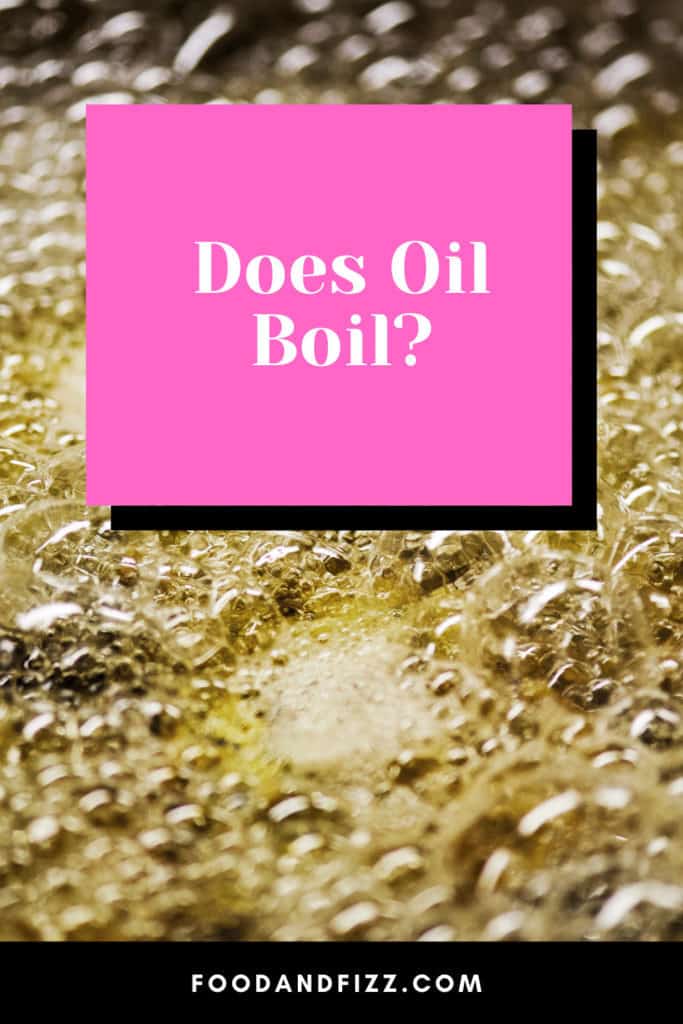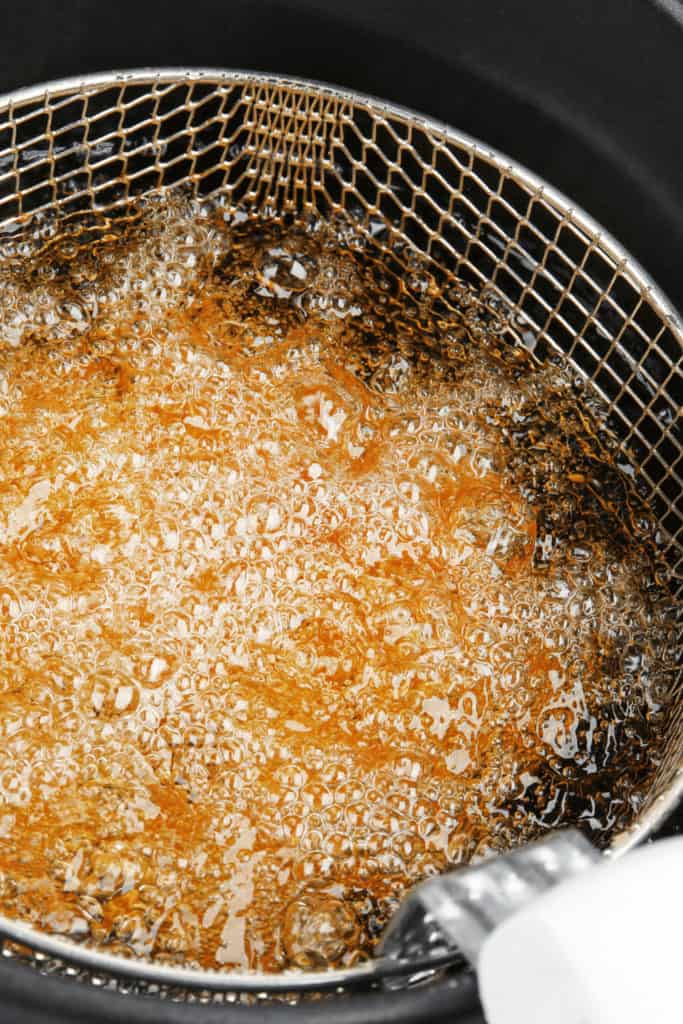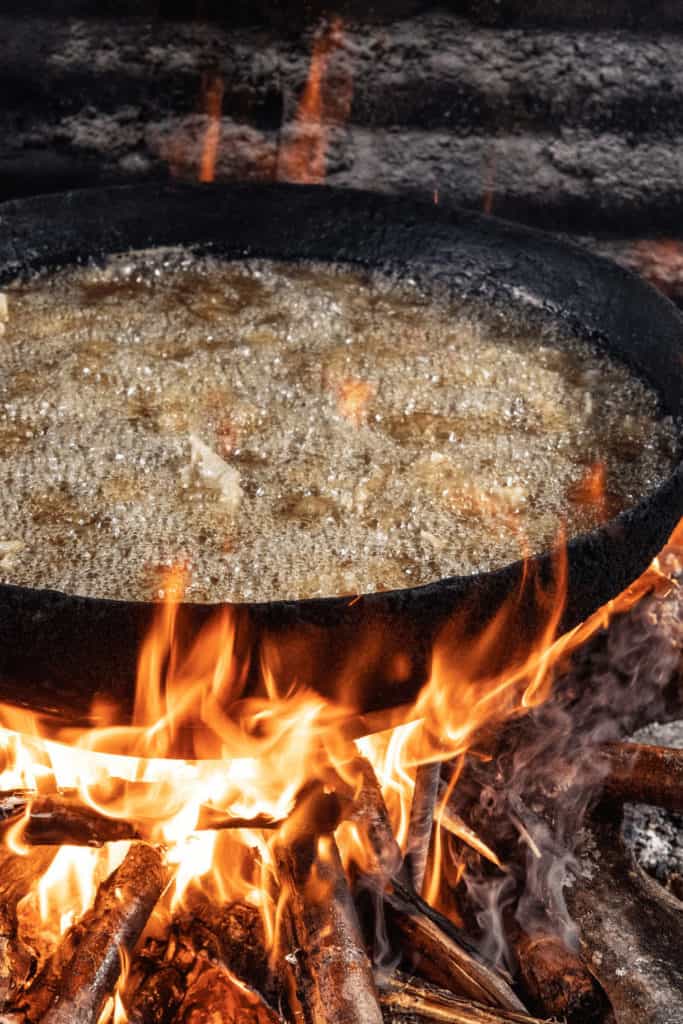When using cooking oil, we hear it bubble and pop when it starts to heat up.
And, of course, we see the extreme reaction that happens when we drop something into the heated oil.
The stuff goes crazy!
However, all that bubbling and reaction is not the oil boiling.
Does oil boil?
To use water when cooking, we regularly bring it to a boil.
However, oil is heated but never brought to a boil when cooking with it.
Does oil boil?
Cooking oil does boil. The boiling point of vegetable oil is roughly 575° Fahrenheit (302° Celsius). However, if you ever get your cooking oil to its boiling point, the oil will be ruined and in danger of catching fire. To use cooking oil effectively, you should pay attention to its temperature and never let it get to a boiling point.

Cooking Oil Smoke Point
As cooking oil is heated in a pan, you will notice the occasional bubbles that pop. This is not the oil heating to a boil.
When the food is put in hot oil, it roils like crazy. This isn’t boiling either. This reaction is moisture from the air or food being cooked vaporizing in the oil.
A far more important temperature than the boiling point of cooking oil is the oil smoke point.
An oil’s smoke point is the temperature at which the oil stops being useful and begins to smoke. And this can negatively affect your cooking.
When your cooking oil reaches its smoke point, it starts to break down.
When the oil breaks down, it can spread different chemicals through the oil that make food taste burnt, bitter, or bad. Generally, if your oil starts smoking, it is too hot.

Cooking oils have a wide range of smoke points. And, it is pivotal that you know that the oil you plan to use has a smoke point that can handle the temperature at which you wish to cook.
Besides flavor, the smoke point is probably one of the most popular reasons certain oils are used more than others.
For example, extra virgin olive oil has a low smoke point somewhere between 325° and 375° Fahrenheit.
So, while many love the oil for its health properties, it is not ideal to deep fry food at high temperatures with this oil.
On the other hand, the infamous peanut oil has a high smoke point of 450° Fahrenheit.
That high smoke point and its delicious flavor make it ideal for deep frying food. Just not for those with nut allergies.
What is most interesting is that cooking oils have a smoke point far below their boiling point.
So, oil heated past its smoke point already starts to break down and becomes unusable.
Cooking oil works best when kept under the smoke point and far below boiling temperature.

Oil Flash Point and Ignition Temperatures
Now, while you should never continue to heat oil after it starts smoking, just because the oil is smoking does not mean that the pan will burst into flames.
Two other important temperature points warn of a potential grease fire.
Those points are the flashpoint and the ignition point.
An oil’s flashpoint is the temperature at which it is hot enough that a stray spark, flame, or other forms of ignition will ignite the vapor on the surface of the oil for a few seconds.
The oil will not be hot enough to sustain complete combustion at the flashpoint.
So, if you neglect a pan of oil and see some flames dancing on the surface, you may be able to get the pan off the burner, smother it, and let it cool because it is only at the flashpoint and isn’t hot enough for a sustained grease fire.
Generally, most oils reach a flashpoint around 600° Fahrenheit (316° Celsius).
Remember, oil boils right around this point as well.
Also, please notice that this point is well beyond the smoking point of cooking oils.
After the flashpoint, there is the actual temperature that the oil will catch fire by itself, and you will have an all-out grease fire on your stove called the ignition point.
For oils to reach this point, most have to get upwards of 700° Fahrenheit.
If your oil does ignite, there are a few things to know.
Never, never, never ever try to extinguish a grease fire with water.
Water will make the fire spread. If the fire is small enough, you can try to smother it with the pan’s lid or baking soda.
Your best option is to have a fire extinguisher in your kitchen rated to extinguish a grease fire.
Frequently Asked Questions About Does Oil Boil
Can I reuse oil that was heated to the smoke point after it cools?
You can try to reuse oil after it is heated to the smoke point. However, be prepared to toss the oil if the food doesn’t taste right. It should be OK if it was at the smoke point for only a short time. You will be able to taste the difference if the oil is ruined.
Why does oil sometimes flare back up and reignite after it is smothered and removed from the heat?
After the smoke point, oil starts to break down. And, after it ignites, that chemical breakdown continues at a rapid rate. As the oil chemically changes, the ignition point temperature can also change. Even as the oil is removed from heat, it still may be hot enough to reignite.
Conclusion About Does Oil Boil
While cooking oil does boil at extremely high temperatures, you don’t want to see it get that hot.
Boiling temperatures in oil are well past the smoking point, and therefore the oil is not good for cooking anymore.
Generally, the oil comes to a boil only in cases of a neglected pan that potentially could cause a grease fire.
So be vigilant, and don’t let your oil get too hot!

